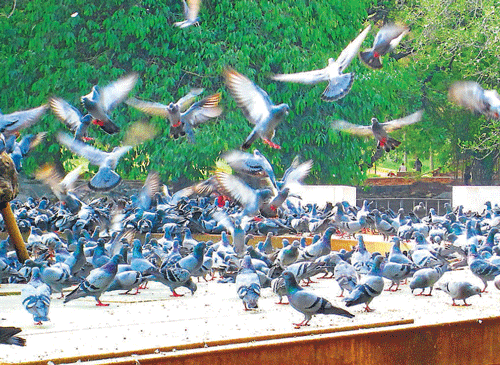
Urban biodiversity says a lot about the health of a city – a healthy city constitutes a healthy biodiversity.
Biodiversity conservation in urban areas is imperative to sustain the various ecosystems thriving in it. Concurrently, a misguided upkeep of wildlife in urban spaces that is seemingly harmless and aesthetically appealing can also be catastrophic. A case in point is the recent boost in Rock Pigeon population in Bangalore.
The Blue Rock Pigeon or Columba livia is a member of the bird family Columbidae, which includes doves and pigeons. They are said to be the first birds to be domesticated in around 4500 BC, being raised first for their meat and later for their message-carrying ability. The species originally found in the wild in Europe, North Africa, and Western Asia includes domestic pigeons and escaped domestic pigeons, which have given rise to feral populations around the world.
Pigeons were used extensively in wars to carry messages in the 20th Century. The pigeon has also been revered in many religions. They are still venerated today, with huge flocks of pigeons being fed on a daily basis in places of worship throughout India, UK and many other European cities. The feral pigeon found in urban areas exists exclusively on a diet of seed – normally from human sources – and human refuse, such as fast-food waste.
While some urban dwellers enjoy having friendly pigeons around, pigeons can be a nuisance, especially around roosting sites. Of late in Bangalore, there has been an alarming increase in the number of pigeons being fed by the public. In Lalbagh, Cubbon Park, at the railway station, playgrounds, city market, residential layouts, roadsides, on rooftops and in the vicinity of Prani Daya Sanghas, people feed thousands of pigeons every day.
Faecal matter, feathers and scales falling off from the pigeons cause allergies and various kinds of breathing troubles in humans. Their acidic faeces eat away metal structures, erode stone buildings and burn lawns. The birds and their nests harbour fleas and mites which could invade homes, if one is not careful.
There have been various reports, coming from around the world, that their droppings harbour a variety of disease-causing fungi and parasites. Large faecal accumulations may present a health hazard to humans. Germs living in the bird are passed on to humans when they defecate into a human food or water source. Fungi growing in pigeon droppings cause diseases like Histoplasmosis and Cryptococcosis.
While cleaning droppings of a pigeon, a person might breathe in some of these fungi which, in cases of high exposure, can cause an infection. Symptoms of Histoplasmosis begin to appear about 10 days after the initial infection and includes fatigue, fever and chest pains. In a potentially fatal condition, Cryptococcosis can lead to Cryptococcal Meningitis. The symptoms start with a migraine headache that won’t go away. The debilitating illness attacks the spine and brain, causing severe swelling. But the most devastating side-effect is blindness.
Another rare bacterial infection spread by pigeons is Psittacosis (Ornithosis). The symptoms are fatigue, fever, headache, rash, chills and sometimes pneumonia.
Pigeons play a considerable role in the spread of an yeast infection called Candidiasis. The disease affects the skin, mouth, respiratory system, intestines and urino-genital tract.
Healthy people usually do not get infected by these fungi and bacteria even at high levels of exposure. However, most people do not show any symptoms. Cancer patients or people living with HIV/AIDS and those with compromised immune systems are generally more at risk.
Also, in cities, the increase in the number of pigeons has led to the disappearance of many smaller granivorous (grain-eating) birds like sparrows with which they compete for food. Sparrows and pigeons share the same resources to feed on. Compared to the tiny sparrows that feed in infinitesimal flocks, hefty pigeons which forage in large flocks consume a substantial quantity of the food that is being shared by both the groups.
High-rises and changes in construction patterns do not affect the populations of pigeons which originally hail from the tallest cliffs in the wild, while the sparrows are being displaced by such urban edifices. Moreover, sparrows require specific roosting places like thatched roofs and old-styled electric poles with wires strewn haphazardly, and minimal vegetation.
A lack of both has led to their gradual exit from the city. NGOs, civic authorities and concerned citizens in the city need to undertake inspections at key locations to assess the gravity of the situation and take steps accordingly. Awareness needs to be created on the practice of feeding pigeons in public places so that there is no undue pressure on other species and human health concerns do not escalate.